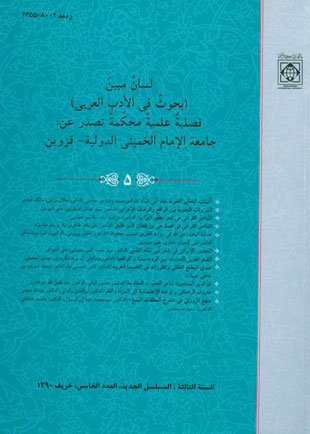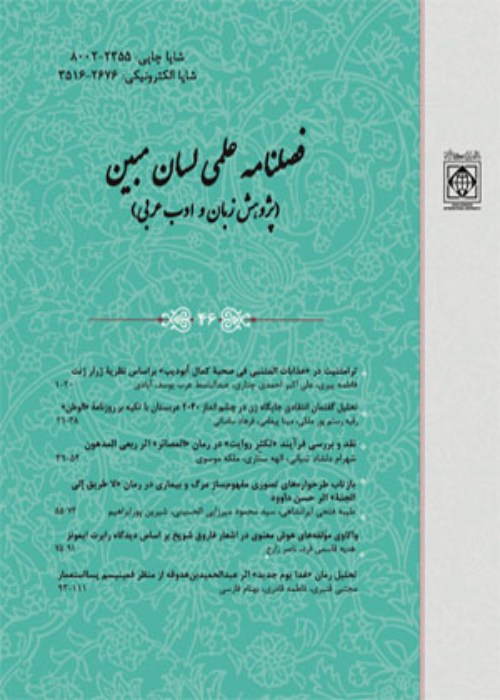فهرست مطالب

فصلنامه لسان مبین (پژوهش ادب عرب)
پیاپی 5 (پاییز 1390)
- 250 صفحه،
- تاریخ انتشار: 1390/11/01
- تعداد عناوین: 12
-
-
صفحه 0
-
صفحه 194
-
Page 1Mozaffar Navvab, one of the most important modernist poets, who was and still playing a prominent role in raising awareness and exposing the political defeatism of governments. He also has a notable role in the poetic creativity through the use of techniques that keep his poetry away of the limits of direct and public speaking, such as “Intertextualtiy “and specially the Koranic one where he employed the full verses omitting or exceeding it, also he enlisted the names of “SURATS” and the names of prophets and their stories, and with a unique ability he gave it new signs and suggestions while retaining the moral religious shipment of the absent text in his new texture. He also added an aesthetic and artistic dimension to the text so that it can impress the reader and draw him to the center of text.Keywords: Koranic Intertaxtuality, poetry, Mozaffar Navvab
-
Page 20Nowadays literary schools or styles are some terms which are heard a lot in academic circles. These various styles which are mentioned in literature especially in the history of European literature were formed on the 16th century the peak of Renaissance and humanism and were developing by Classicism in 17th century. It could be said that these literary styles are somehow remnant of ancient methods of Greek Rome or mediaeval. Literary schools were not invented or discovered by a single person or any particular group to be appeared suddenly andsurround whole the literature. In this paper we try to discuss one of these styles Realism so primarily we will have a quick review of this literary style then we will discuss the realism of it supremacy on Romanticism.Keywords: New Arabic poetry, literary schools, Romanticism, Realism
-
Page 49Considering the importance of the Moallaqat in Arabic literature are the valuable works of pre-Islamic literature, and they have elegance in their words, phrases, imaginary, and many of the Moallaqat Couplets are the Evidences in old Syntax books …so, many of the scholars have paid attention to these odes, and studied them from many basis such as criticism, words, syntax, … and there are many expositions of these odes in the Arabic history. On the other hand the methodology of the explanations as the valuable key in explaining texts and judging them is important for researchers and scholars. and considering the reputation of the Zuzani book, in the present study, it is intended to study the method of Zuzani in his book "the explanation of the Moallaqat" in order to analyze and examine the method of Zuzani, descriptive - analytical method was employed. The results of the study revealed that Zuzani emphasize the meaning in his book and pay attention to syntax, metaphor, narrative, so his book is a didactic book.Keywords: Methodology, Moallaqat, explanation, Zuzani, the explanation of the Moallaqat al Sab
-
Page 82This research has considered the issue of some grammarians,syntactic justifications and the description from which their misrepresentations originated. It is safe to mention that plenty of these grammarians have confused between some syntactic descriptions and the real grammatical functions (or role). Moreover, such syntactic justifications become more obvious in the problem of ''Similar to Object of a Verb ''; because the objective of grammarians has been to describe an unusual state, not to express the grammatical function (or role) and its principle.Keywords: Syntactic Justification_the Final Vowel of an Arabic Word_Description_Similar to Object of a Verb
-
Page 106From ancient days, Human being has been searching for the Creator in the existence, and has asked several questions regarding the cause of his/her existence in this world and about his/her futurity. Najib Mahfouz in his novel, «road», searches for the God and talks about numerous questions related to destiny of defenseless miserable human and takes the name of «Saber» as the hero of his novel, which stands for Holy patience. Also «Sayyed Sayyed Rahimi» is a symbol of God, because Allah is the Master and he is the master of humans. The novel begins and ends in a symbolic perspective and it is the philosophical frame which enables Najib Mahfouz using intertextuality. In this article, internal and external Quran intertextuality has been studied. We try to analyze purpose of the author from using Quran intertextuality and symbols in the dialectic of search for God in this novel. Research method of this article is descriptive-analytical approach that is based on summoning the absent text in the novel of road.
-
Page 121Al-Rassafi the great Iraqi poet is one of the forerunner of literary movement and one of the greatest of classical poets, has composed many poems on admiration and description in the form of sonnet. However he is unique and well-known for his social and political poems. He has been called “poet of freedom “and “poet of the poor” because of his concern about political and social issues and his revolutionary and radical poems. His poems have many characteristics; beside the dignity of his language and magnificence of his style his verses are in line with the situation of his era and its needs, since the environment which the poet lived in was full of poverty. Rassafi prefers to devote himself to the social and national affairs, and the suffering of his contemporary people. These factors made al- Rassafi a great social poet and caused him to feel the pains and sorrows of his people in the depth of his heart. When we read his poems and concentrate on his odes we will find it like mirror in which political events, national movements, and social revolutions of his time are quite evident. He is the only Iraqi poet who distinguished his social poems. In this paper we are going to investigate the most important social tendencies of the poet, i.e. women and poverty.Keywords: Al, Rassafi, Social tendency, modern poem, Iraq, women, poverty
-
Page 138Intertextuality is a new term which applies to the mutual interaction among texts. That is, the interpretation of every text is dependent upon the texts preceding it and the creation of a new text is the result of interaction taking place in the mind of the writer among several texts the concepts and stories of the holy Koran are texts of paramount importance in Arabic literature which have inspired both old and new literary men in the creation of their works. Ibn-e Tofeil has made use of the texts of the holy Koran as an absent text in his story of Hay Ibn-e Yaqzan. This is considered an Intertextuality of religious, explicit, direct and external type which has manifested itself mostly in vocabulary and spiritual domains. This study is set out to investigate different kinds and the quality of the materialization of the Koranic Intertextuality in the story of Hay Ibn-e Yaqzan.Keywords: Literary criticism_the holy Koran_Intertextuality_Hay Ibn e Yaqzan
-
Page 152The well-known Palestine poet “Ezzoddin Monasarah” lives in Jordon. He is the poet of the 60’s of 20th century. He has been so effective in the poem new development and supporting the modernization of poem in some countries like Palestine, Jordan, Lebanon, Egypt, Tonus and Algerias. He is an international poet who is affected from the poem new development and also is effective in that. He is famous in Iranian cultural societies because of the Farsi translation of his selective poems (Sabre Ayoob, 1996m).although Monasereh’s poem has been analyzed a lot, but because of its great beauty, it is needed to be discovered more. This article is about the relation between modernization, love and resistance in Monasereh’s poem. He has put big purports in his short poems by few words. He has related the resistance, love and modernization. And he is an imminent poet in the Arabic literature because of this reason.Keywords: Ezzoddin Monasarah, resistance poem, Palestine, love, modernization
-
Page 168Structure of ode in Arabic literature have never left limited in opening-verse. Talali (poems about hills and mounds)’s openingverse generally was being various and like artistic picture. Old Arabic poets used opening-verse in several ways. They used for stating love or some poets used for dead power. But some poets have not composed Talali’s opening-verse and some liked it. Of course some group like Abi-Noas Ahvazi and his sympathetic people tried to collate them. In the end, the major matter in this paper is studying the changes of Talali’s introduction in various periods.Keywords: Talali's introduction, Moallaqat, stating hills, reason of stating hills, Arabic ode
-
Page 194Abu-Tammam is one of the rational in Abbasid era who has used the implicating linguistic tools for the expression of his own thought content. This study aims to investigate his capability on the understanding of different language implication and also his subtle utterances via using linguistic tools in four categories: phonetic, morphology, syntax and lexicon, so that we can discover some toolbased methods of this thoughtful poets on the expression of his own thought principals and know, which considering the meaning of ambiguity and vagueness, why this poet has chosen the word “ALHEQBAH” which is more ambiguous and vague compared to its similar word “AL-HOQOB” the former portrays more length and unclearness in time for the audience and since he aims to clarify the rapid movement and the fast and rotational leap of camels and their running flow on this utterance. He has chosen the word “RATAKAN”, which is based on its phonetic morphologic structure, derived from the rhythm of “FAALAN” and the sequence of “FATHE”, the phone of a, on its three letters show clearly the meaning of joyfulness and shaking in that camels leap. From syntax and morphology point of view, this article also tries to achieve some clues on tool-based style of Abu-Tammam in implicative field of language.Keywords: Abu, TammEm, phonetics, phonology, morphology, syntax, lexicon, semantic
-
Page 217Of renowned poets in 'Abbasid era, is Abu-TammEm. Some reflection of Iran's appearance and Iranian culture can be seen within his poems. There are three main entrance origins to start with (deal with) the appearance as follows: 1. His presence in Iran so as to have (gain) access to and approach 'Abdol Allah Ibn TEhir's court. 2. His acquaintance with Iranian (Persian) language, culture and customs influenced by their expansions in Islamic society. 3. Battles and wars which belong to BEbak revolted against Mutasim. Outstandingly reflected in Abu-TammEm's poems, all of these battles and wars happened in Iran area, especially Azerbaijan. In this research, manifestations of the reflection (i.e. Iran's appearance and Iranian culture) within Abu-TammEm's poems have been assessed and it has been tried to properly analyze it.Keywords: Abu, TammEm, Iran's Reflection, Iranian Culture, Azerbaijan, BEbak


